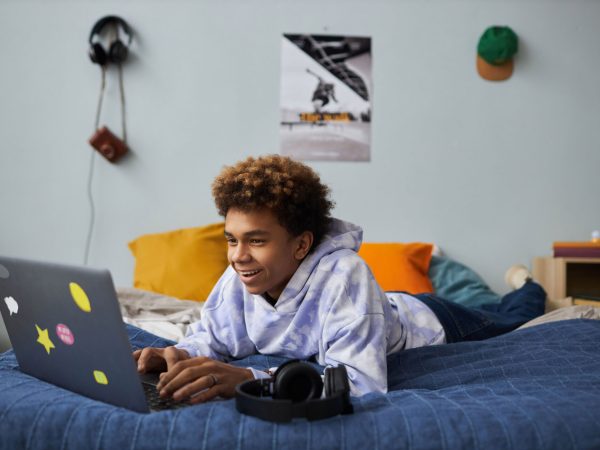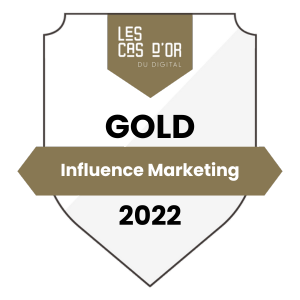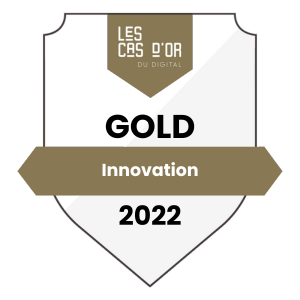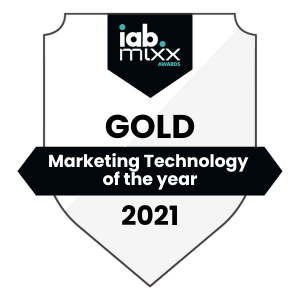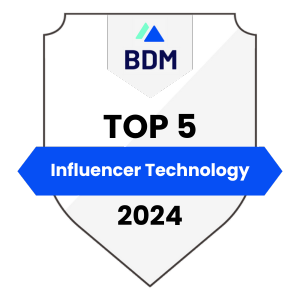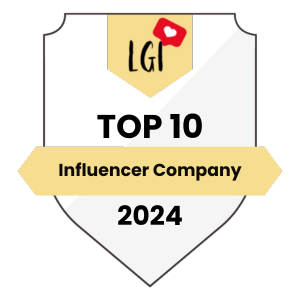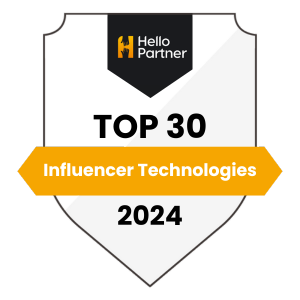The Creator Economy now includes over 200 million creators worldwide1. And with them comes an exponential number of posts, stories, reels, hashtags… every day.
That’s what we call social media noise. So, in the midst of all this, how do you find the perfect creator for your next campaign… and the one after that?
In this article, we’ll show you how to find the best influencers in 6 clear steps, and how tools and technologies (such as Stellar’s Discovery module, now enhanced with AI) help you move faster, more precisely, and with even greater impact. 🚀
Best practices to choose the right ambassadors
Finding the right influencers starts with a clear understanding of your goals, a true grasp of your audience… and powerful tools to explore, filter, and activate the right profiles.
Here’s a step-by-step guide of best practices to structure your thinking, avoid casting mistakes, and lay the foundation for truly effective collaboration.
At each step, you’ll find a key question to help you get straight to the point, along with a selection of the best tools to get you there.
Step 1: Clarify your goals to avoid off-target profiles
Awareness? Consideration? Conversions?
Each goal calls for different types of profiles, on different platforms, with different formats.
To increase awareness, go for high-visibility profiles, even if they’re less expert.
To drive sales, prioritize those who know how to activate their audience (with clickable stories, promo codes, etc.).
To build consideration (brand preference), look for creators who can produce authentic, engaging content and tell a real story around your brand.
💡For example, to generate buzz around a product innovation, Nintendo launching the Switch 2 or L’Oréal Paris releasing a new skincare product won’t look for the same kind of creators. The right profile is the one that fits your objective — not necessarily the one with the most followers.
Find creators based on your goals with influencer marketing platforms
Thanks to AI, influencer platforms now offer access to structured catalogs that centralize millions of profiles and make them comparable.
They’ve become predictive tools, able to understand your intent, identify the most relevant profiles, and suggest tailored recommendations.
What’s the point of an influencer catalog?
Explore an influencer market by platform, theme, audience, or country
Find relevant profiles based on your goals: awareness, conversions, UGC…
Compare multiple creators using identical criteria (KPIs, history, engagement…)
Save precious time by avoiding manual research
Beyond a simple database, the catalog is a strategic tool to move faster and smarter, without sacrificing quality.
Example: finding creators with the Stellar catalog
The Stellar platform gives you access to a catalog of over 100 million creators, powered by AI, to quickly identify profiles aligned with your marketing intent.
With advanced filters, you can, for example:
Target high-visibility creators (for awareness): by filtering by number of followers, but also by reach, reel views, or audience growth
Find those who know how to convert: by cross-referencing engagement rates, use of promo codes, post frequency
Spot profiles that build true brand preference: natural storytelling, authentic content (visible in post history), consistency in collaborations
A huge time-saver, with structured research aligned with your campaign goals.
💡And with Stellar’s brand new AI thematic search, just type in a topic or intent (“healthy snacks for students”, “digital minimalism”, “beauty care”) — the platform understands your idea, breaks it down, and returns the best profiles.
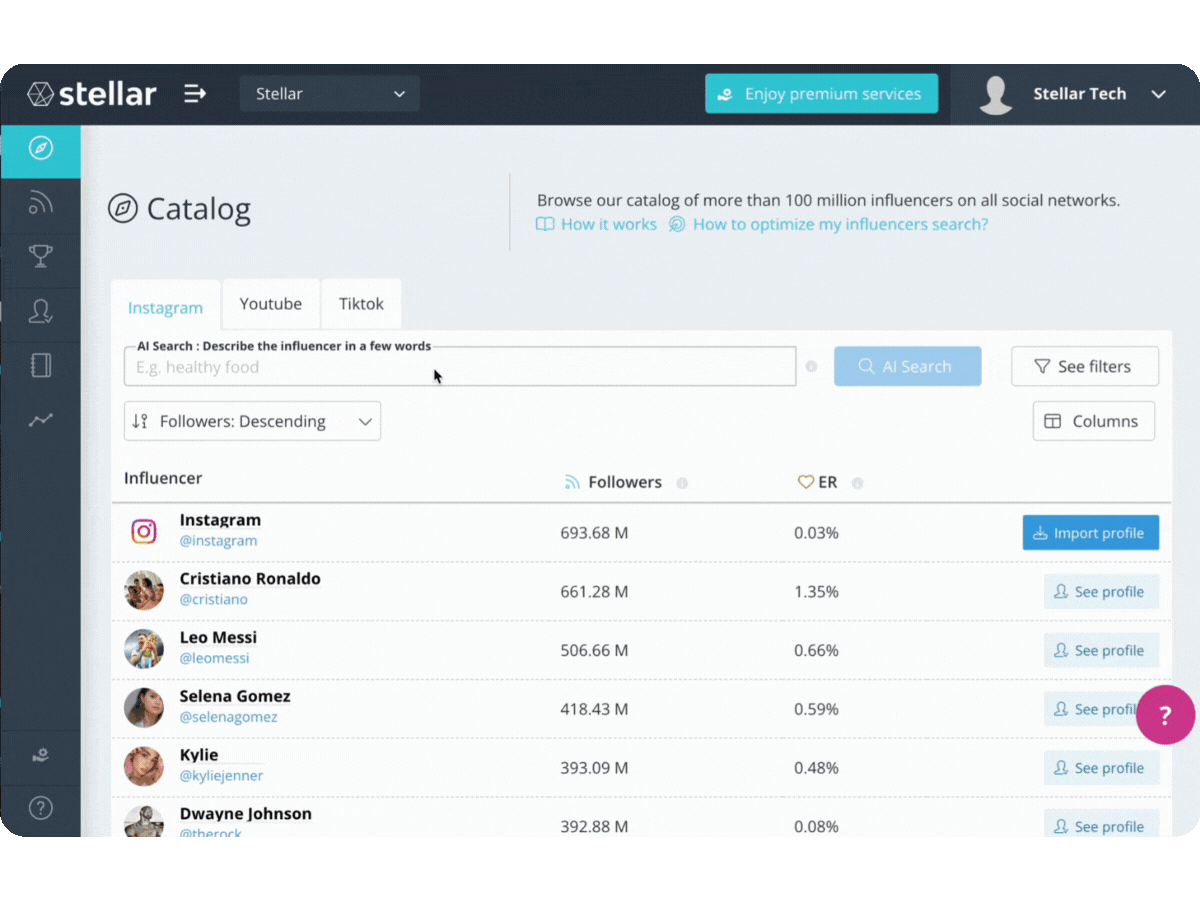
Step 2: Use the right KPIs based on your goals
Once your goals are set, you need to know which indicators to track to ensure you’re on the right path.
For example:
For awareness campaigns, focus on reach, impressions, or views per content piece.
For engagement campaigns, look at comments, shares, completion or reaction rates.
For more transactional actions, focus on clicks, conversions, promo codes, or generated traffic.
Don’t forget to also track:
organic growth of the community
posting consistency
performance stability across several campaigns…
💡Want to see even more clearly? Check out our complete KPI guide for influencer marketing!
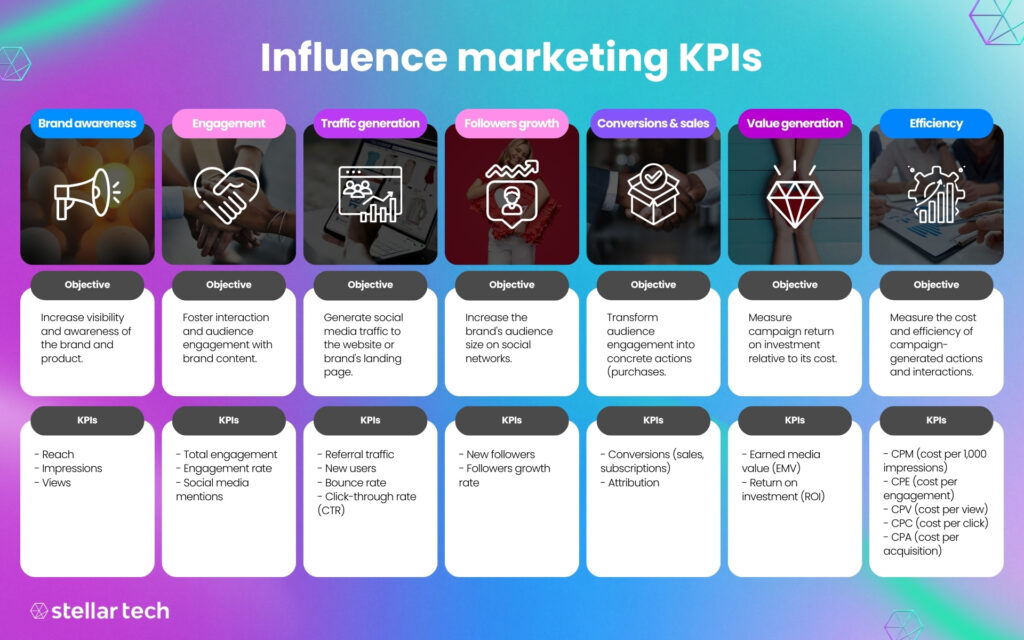
Find influencers based on your KPIs with the right tools
You’ve defined your goals, you now know the key KPIs to track… the next step is applying them to your search.
Let’s take an example: you’re a food brand launching a range of healthy snacks for 18–25 year olds.
Your main goal is to drive sales while building brand preference.
Here are some KPIs you might want to monitor to target the right profiles:
Engagement rate, to assess the creator’s ability to activate their community
Video views, to prioritize real visibility of content
Audience growth, to spot creators with upward momentum
Posting frequency, to make sure the account is active and consistent
Use of promo codes or tracked links, to identify profiles already familiar with conversion
Example: defining your KPIs in Stellar
Here’s how to proceed with Stellar:
1. Access the catalog in Stellar’s Discovery module
You’ll get access to over 100 million influencer profiles worldwide.
2. Type “healthy food” into the “Themes & topics” bar
Thanks to Stellar’s AI semantic engine, the platform understands your intent and suggests relevant profiles with real topical affinity.
You can also phrase your search like an intent (“high-protein snack for students”, “quick healthy recipes”) — the AI gets the meaning behind your brief, even if those exact terms aren’t in the bio.
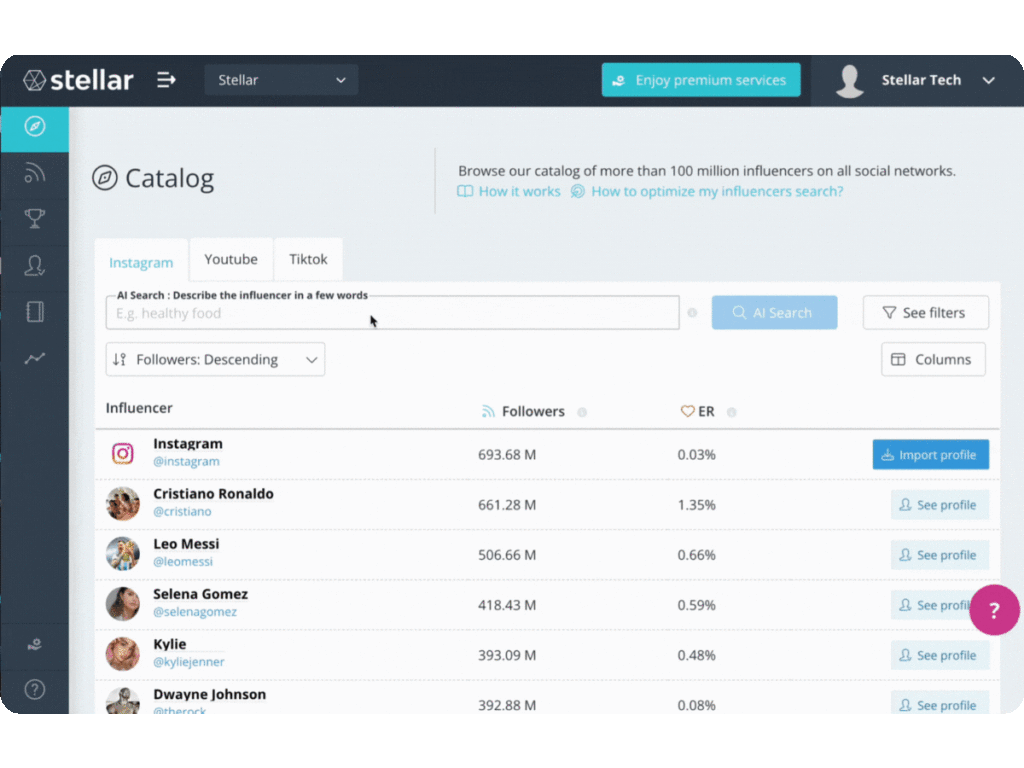
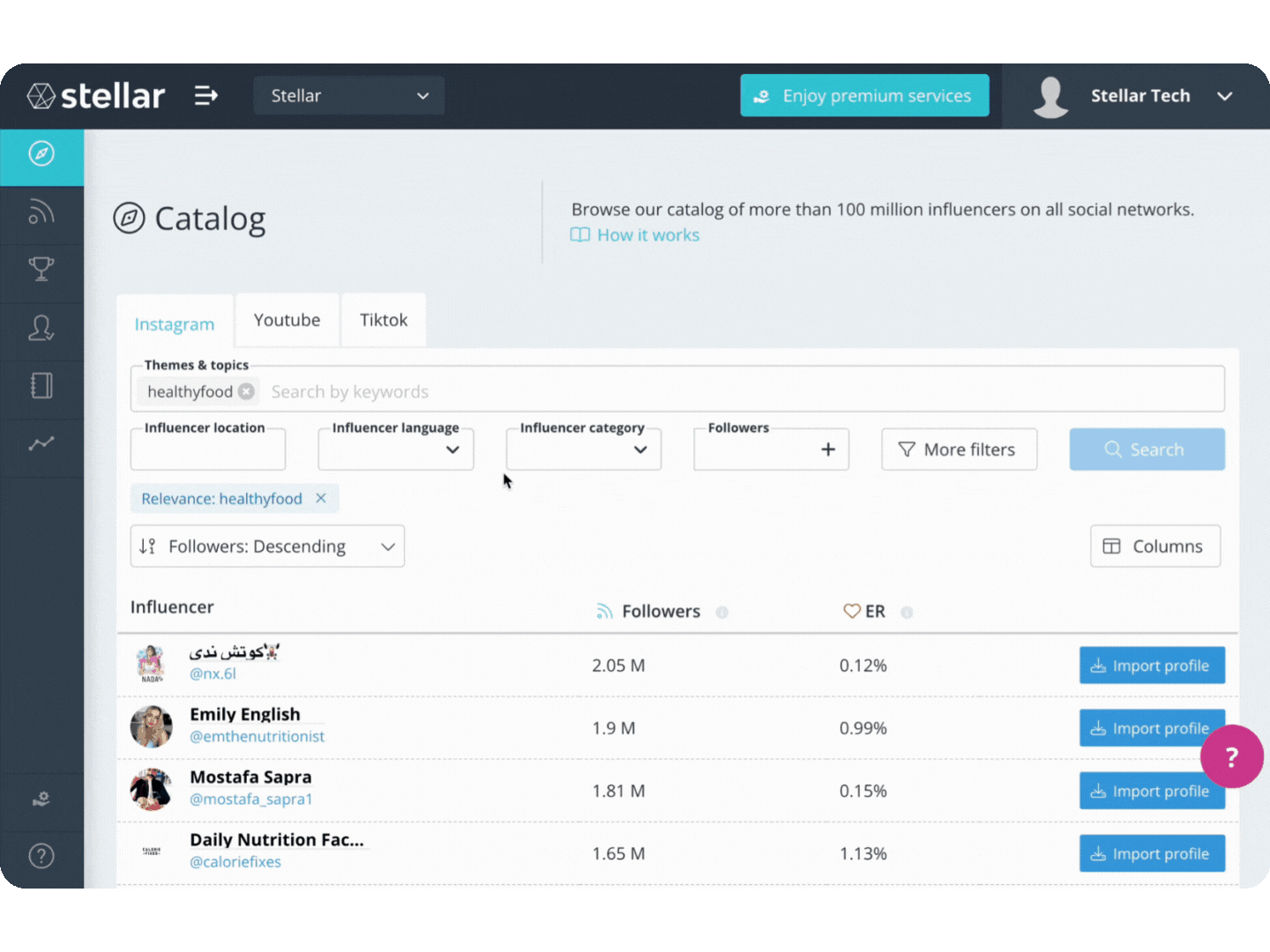
3. Refine using creator filters
• Location: France
• Language: French
• Category: Food, Lifestyle, or Sport
• Age: 25–35
4. Add additional criteria based on your needs:
• Engagement rate > 2%
• Video plays > 20k
• Last post: less than 15 days ago
• Follower growth > 10%
• Mentions of healthy products or hashtags like #healthysnack
5. Add promising profiles to a dedicated portfolio
To easily find them later, compare them, or activate them in your next campaign.
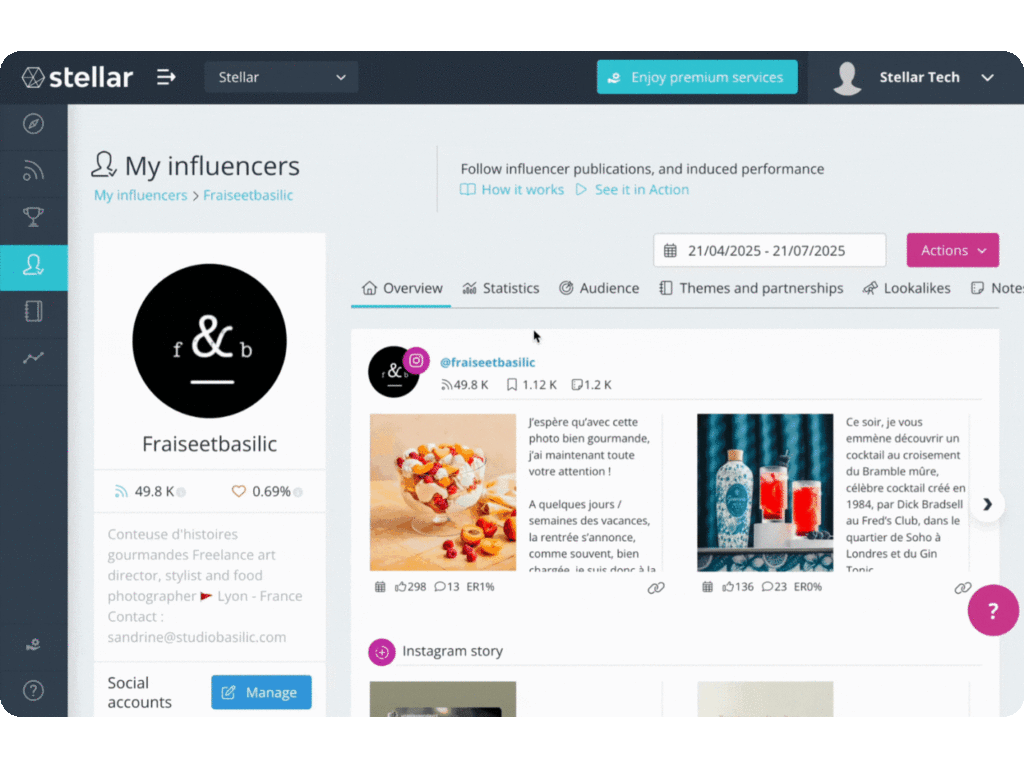
Step 3: Target an audience, not a creator
This is one of the most common mistakes: starting from a profile we like… without asking who they’re actually reaching.
The real question to ask is who their audience is, and whether it aligns with your target market.
Beyond creator-related indicators, don’t forget to define criteria for your audience too:
Check the geographic breakdown (a French-speaking creator might have 40% of their audience in Canada, Switzerland, Morocco…).
Analyze age range, gender, interests.
And check the credibility of the audience, to avoid fake, passive, or bot-driven audiences.
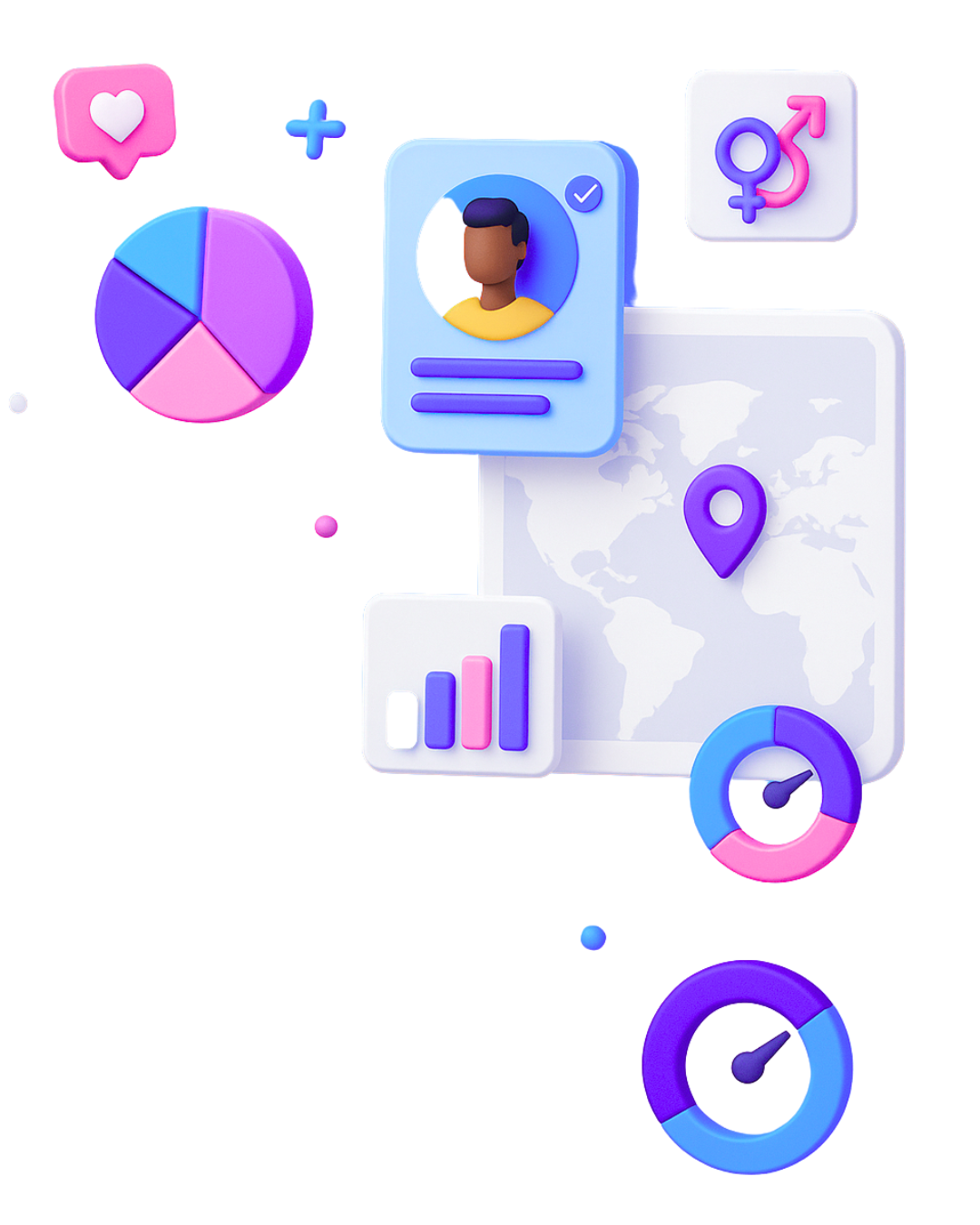
Find the right influencers based on their audiences with Stellar
Once your content and performance criteria are set, look at who the creator is actually reaching.
In Stellar, you can filter not only by creator profile, but also based on their audience characteristics:
Geography: you can target a French, Belgian, or Canadian audience… or exclude certain countries — a French-speaking creator doesn’t always have a primarily French audience, for example.
Age and gender: refine your search to find profiles followed by the right age groups, based on your marketing personas.
Audience’s main language: to ensure the content is understood and engaging, especially in multilingual markets.

Check audience credibility with Stellar
Stellar’s credibility score automatically evaluates the quality of a creator’s audience. It helps you spot profiles with:
an authentic follower base (no purchased followers)
an active audience (no dormant accounts)
a clean history (no suspicious spikes in growth)
Step 4: Make sure the creator aligns with your brand
A good reach isn’t enough; what also matters is the creator’s legitimacy to speak for your brand.
That means going beyond the numbers and observing how they express themselves, to whom, and why.
Look at their profile and ask yourself a few simple but decisive questions:
- Do the creator’s tone, universe, and values align with yours?
- Is their content style consistent with your brand image?
- Is the profile polarizing, very commercial, highly opinionated… and does that match what you’re looking for?
- Have they already worked with brands similar to yours? If so, in what context?
- Do they follow transparency rules (disclosures, legal mentions, etc.)?
Check the alignment between a creator and your brand with Stellar
Beyond the numbers, Stellar gives you concrete data to assess a profile’s legitimacy and trustworthiness:
Collaboration history: view the brands the creator has worked with, the sectors involved, and the frequency of partnerships. A great way to evaluate editorial consistency — and to anticipate potential “bad buzz”.
Sponsored content disclosures: Stellar automatically tracks labels like “paid partnership” or “collaboration” on published content. This lets you verify the creator’s transparency and compliance with current regulations.
“Responsible influencer” certification (coming soon): in France, Belgium, or the Netherlands, some creators hold official status in the sector. This information will soon be available in Stellar to further strengthen ethical and regulatory assessments.
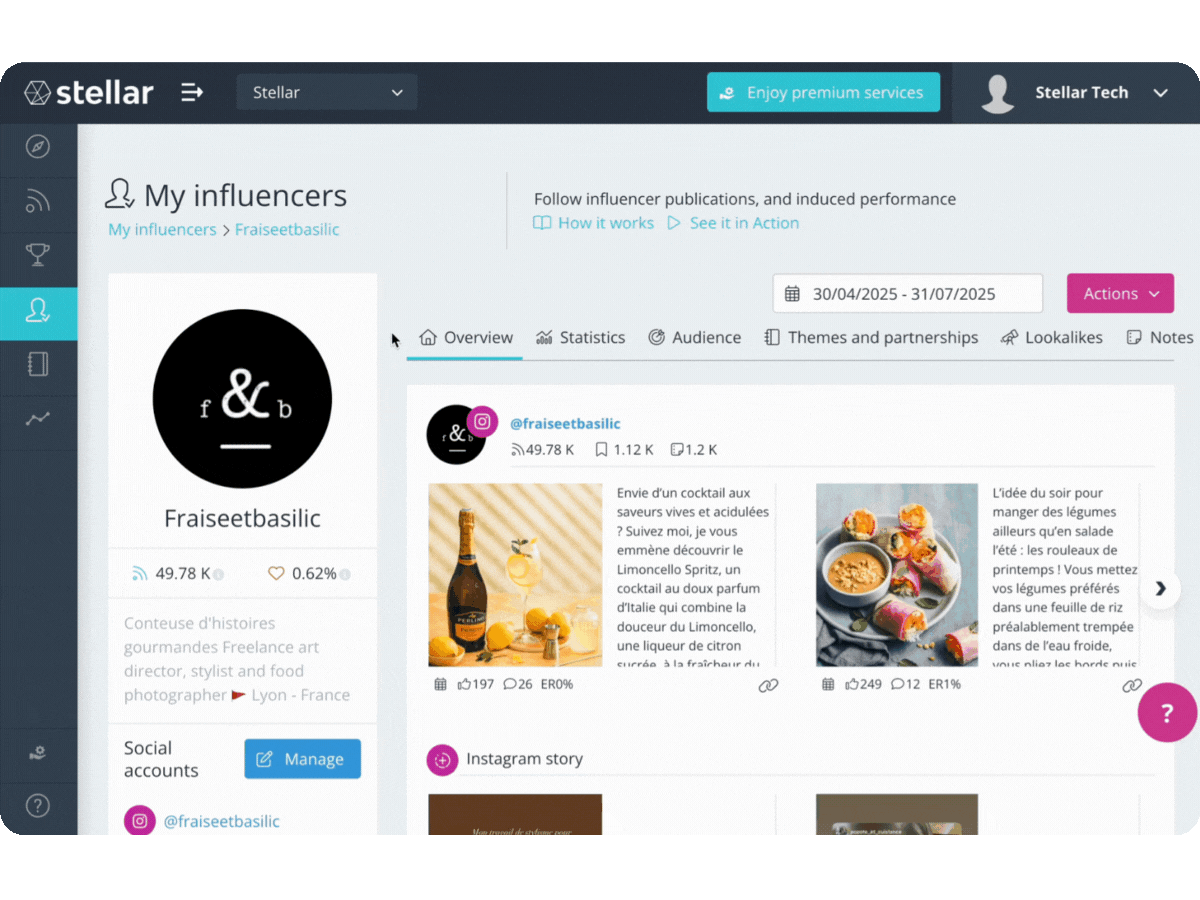
Valuable insights to ensure the profile conveys your messages with fairness, credibility, and accountability.
Step 5: Watch what your competitors are doing
What are your competitors doing in influencer marketing? Who are they working with? And most importantly… is it working?
Competitor benchmarking helps you answer these questions, refine your strategy, spot new opportunities, and better position yourself in the market.
Competitor benchmarking allows you to:
Get a better understanding of positioning: what types of creators are your competitors choosing, on which platforms, and with what storytelling?
Track recent partnerships: ongoing collaborations, the most active brands, most in-demand creators
Uncover performance indicators: average engagement rates, view volumes, formats used (reels, stories, lives…), etc.
Gain insights to stand out: if your competitors are all targeting the same profiles, you might focus on other niches or types
How to find influencers through Stellar’s competitor benchmarking
In the Discovery module, Stellar offers an AI-powered competitor benchmarking tool that lets you:
Compare multiple brands side by side
To see which creators they activate, their results, and their platform choices
Explore a creator’s past collaborations
To check if they’ve worked with your competitors (and in what context)
Identify creators shared across brands
Or on the contrary, talents still untapped in your industry
Spot emerging trends
Like a rising format or a fast-growing audience segment
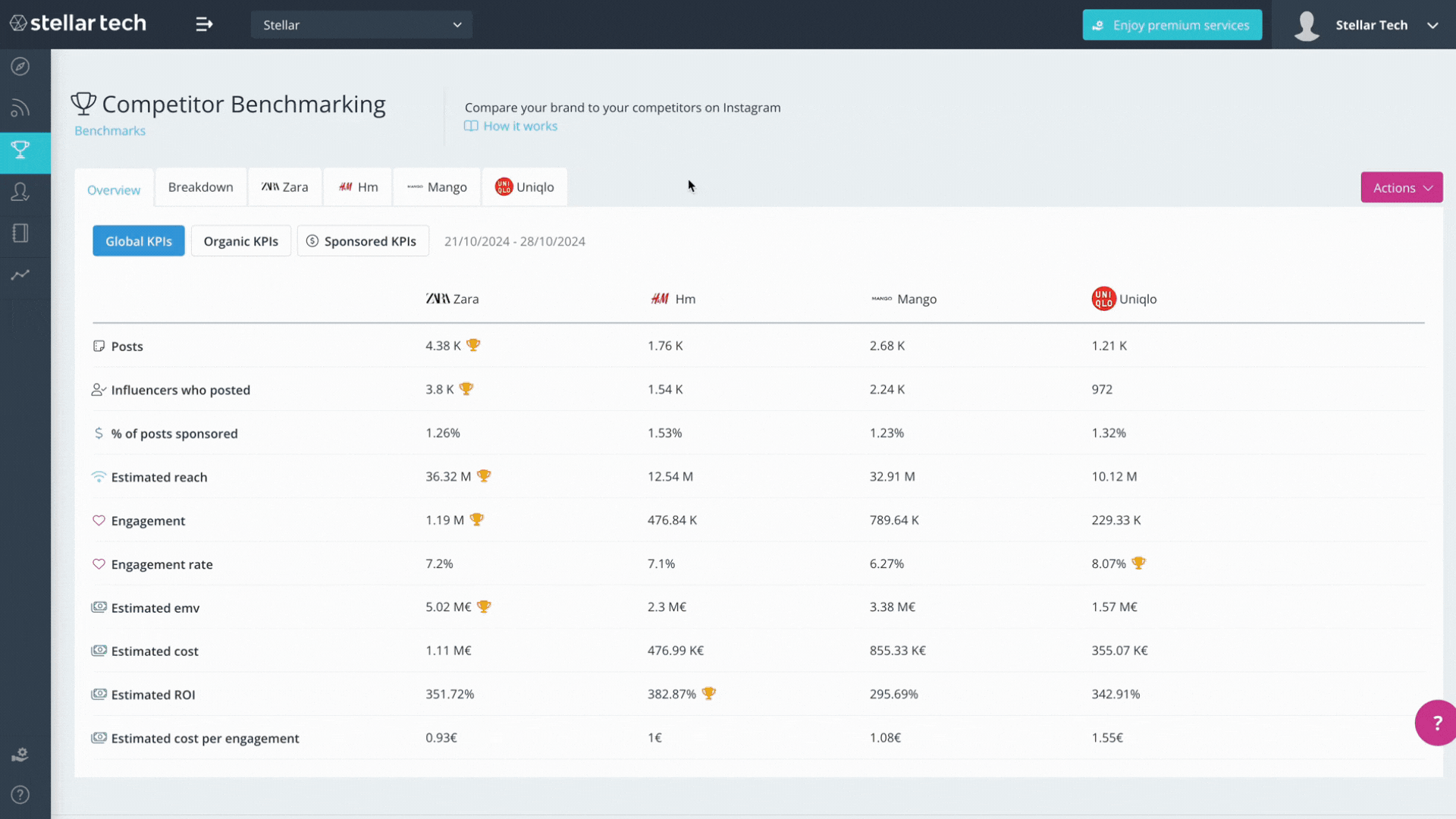
Step 6: Look at… who already loves you
Sometimes, there’s no need to look far.
Some creators might already be talking about your brand without you knowing it. To spot them, check for:
- Those who’ve been following you for a long time
- Those who use your branded hashtags
- Those who regularly engage with your content
- Those who mention you in stories, hauls, or routines
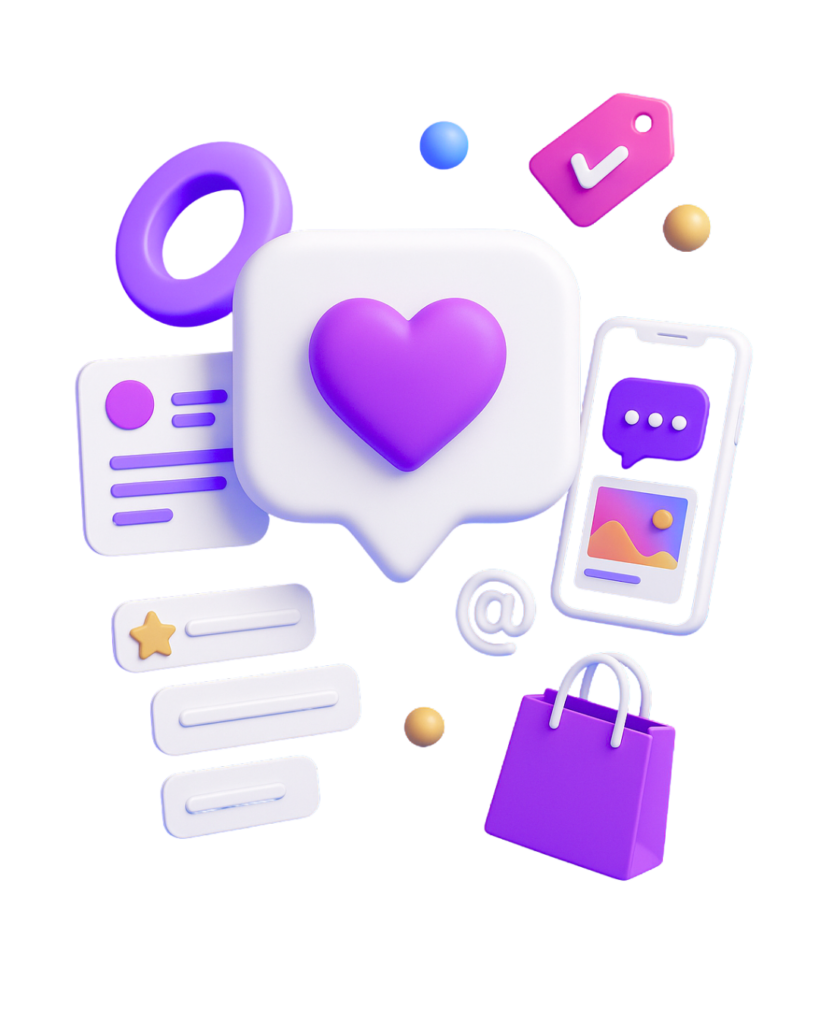
These are often genuine, already-convinced profiles who embody brand advocacy, and they can be a valuable asset for your long-term strategy.
But that’s not all: your employees, loyal customers, and field collaborators can also be powerful relays. We don’t always think of activating them, even though they’re often more legitimate, more credible, and sometimes… more influential than you think.
Social listening: to identify your organic ambassadors
Listening to creators who already know you — that’s what social listening is all about: identifying those who talk about your brand, love it, use it… without ever being briefed.
What’s the purpose of social listening?
Identify creators who already talk about you, even without a formal partnership
Detect weak signals (mentions in stories, hauls, routines, tags…)
Spot engaged communities around your products or brand universe
Social listening is especially useful to quickly find profiles who already love your brand, so you can launch campaigns faster, with more authenticity, legitimacy — and often at a lower cost.
Example: find your ambassadors using Stellar’s Social Listening tool
In Stellar, the Social Listening tool helps you identify all creators who have:
mentioned your brand recently on their social media
used hashtags related to your brand universe (e.g. #cleanbeauty, #hometraining, #zerowaste…)
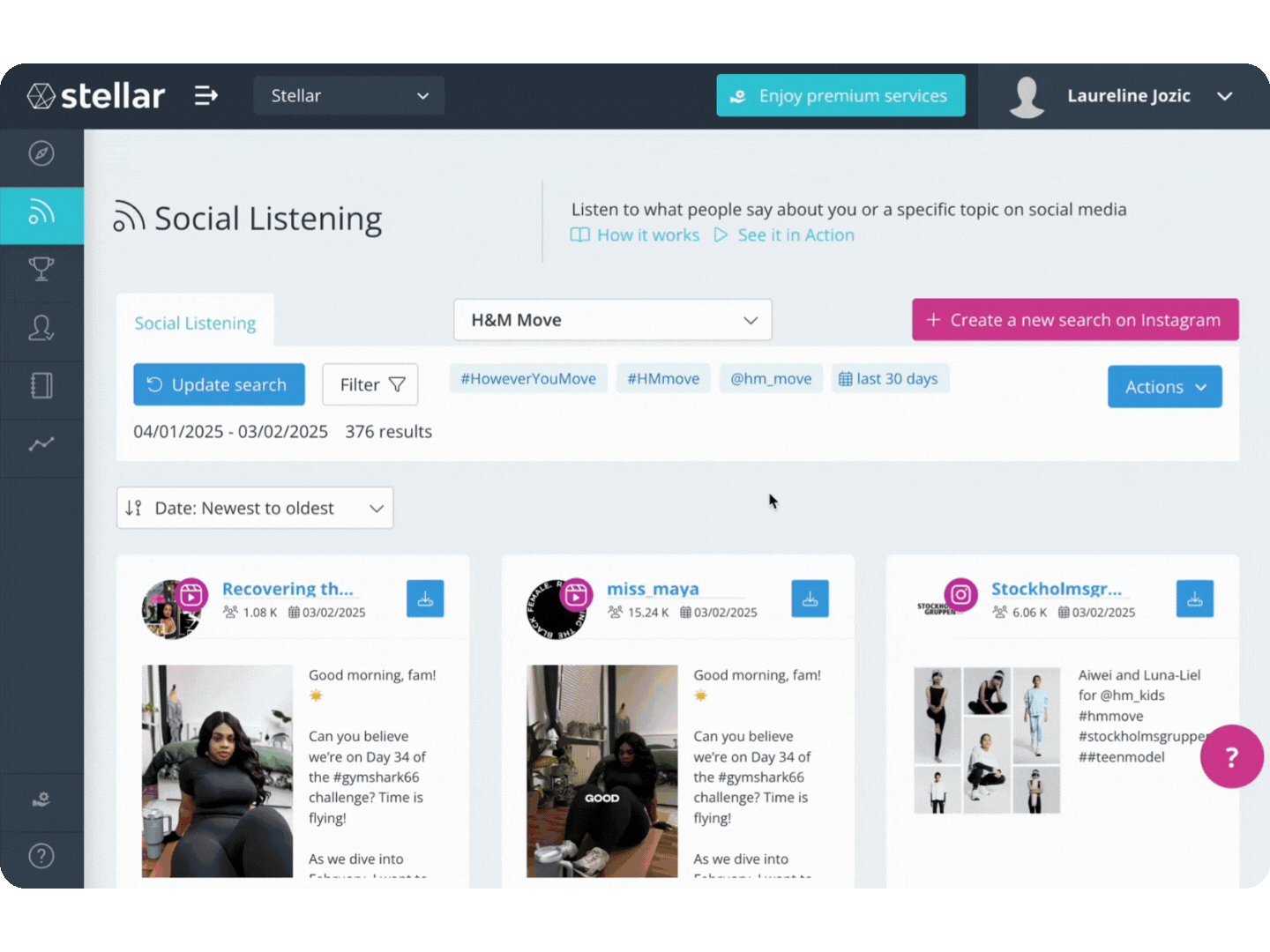
Leverage brand advocacy with Stellar
But that’s not all: beyond Social Listening, Stellar also lets you upload custom lists (e.g. the social accounts of your clients, employees, or internal ambassadors) and instantly see:
- Who has a significant community
- Who posts regularly, with strong engagement rates
- Who could become a credible ambassador for your upcoming campaigns
It’s a simple way to turn your existing circles into a strategic asset: store employees, loyal customers, field partners…
All too often underestimated, but highly effective in influencer marketing.
Bonus: find creators similar to those you already love
Found a creator who checks all your boxes? What if you could find more… without starting from scratch?
That’s exactly the power of the lookalike search feature, which lets you quickly identify:
- creators similar to your reference profile,
- or creators or accounts followed by a comparable audience.
A huge time-saver to expand your portfolios in a consistent way, while also exploring new opportunities.
Find influencers using Stellar’s Lookalike feature
On each creator profile, Stellar offers two complementary lookalike options:
Similar creators
A selection of profiles whose content, positioning, and interests are close to those of the analyzed influencer.
Ideal to expand your shortlist with creators from the same universe.
Similar audiences
Suggestions of accounts followed by an audience with interests similar to your reference profile.
Perfect for targeting multiple creators who speak to the same audience type, even if their content differs.
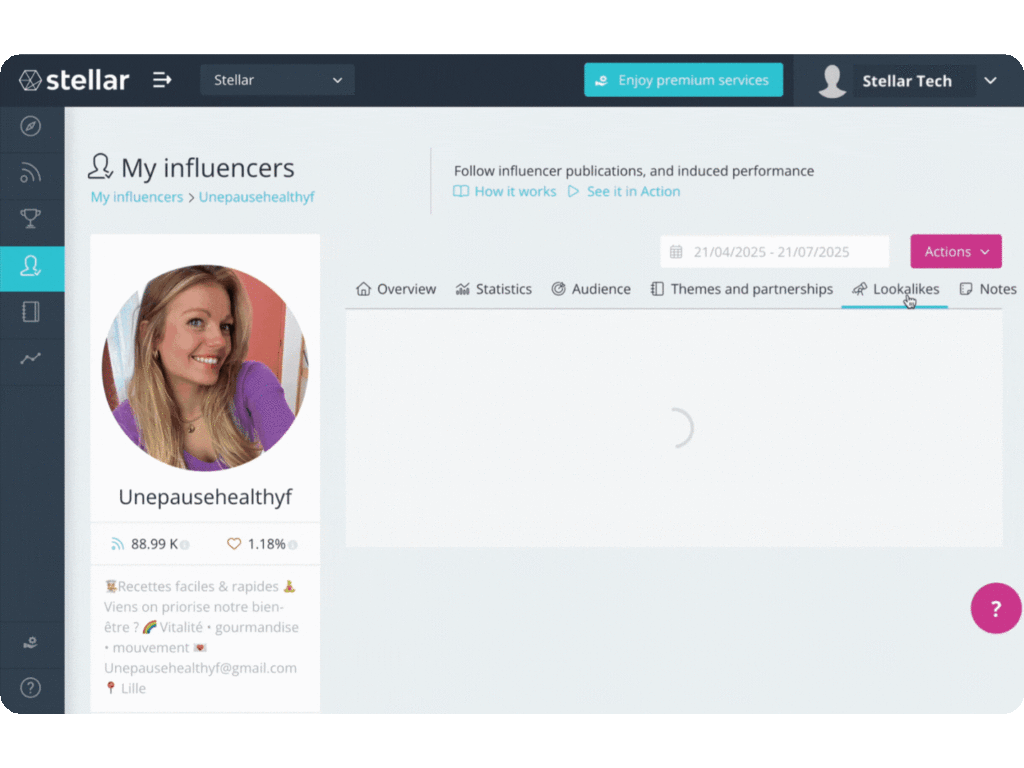
A doubly useful tool: on one hand to enrich your portfolio with relevant profiles, on the other to strengthen your reach within a well-defined audience.
How Stellar helps you find the right influencers
- A global catalog of 100+ million creators
- Smart thematic search, powered by AI
- Advanced filters on creators and their audience
- A double “lookalike” feature
- Integrated social listening and competitor benchmarking
- AI-enriched insights
- Create briefs and schedules in the Projects module
- Manage product shipments, promo codes, budgets, and approvals in one place
- Track results in real time, with full dashboards in Reports
- Analyze performance by content, creator, or campaign
- Measure ROI and EMV, identify top performers, and understand the sentiment behind the comments
Key takeaway: how to find the right influencers (without losing your way)
As you’ve seen: finding influencers — and more importantly, finding the right ones — isn’t just about gut feeling. It’s a method.
Clear goals, the right KPIs, smart tools… every step counts if you want to hit the mark.
Here are the 6 fundamentals to keep in mind (plus one bonus you’ll want to use):
- Define your marketing goals: awareness, conversion, consideration… each intent calls for different types of profiles.
- Choose the right KPIs to qualify them: engagement rate, views, growth, posting frequency… depending on what you expect from the campaign.
- Analyze their actual audience: age, language, country, credibility score… don’t stop at the profile’s appearance.
- Check brand alignment: tone, style, collaboration history, compliance with transparency rules…
- Study your competitors’ strategies: to get inspired, avoid missteps, or uncover untapped niches.
- Spot your organic ambassadors: social listening, internal lists… your best brand advocates may already know you.
Bonus: find lookalikes: One good profile can lead to others! Identify similar creators or twin audiences to broaden your options — without starting from scratch.


